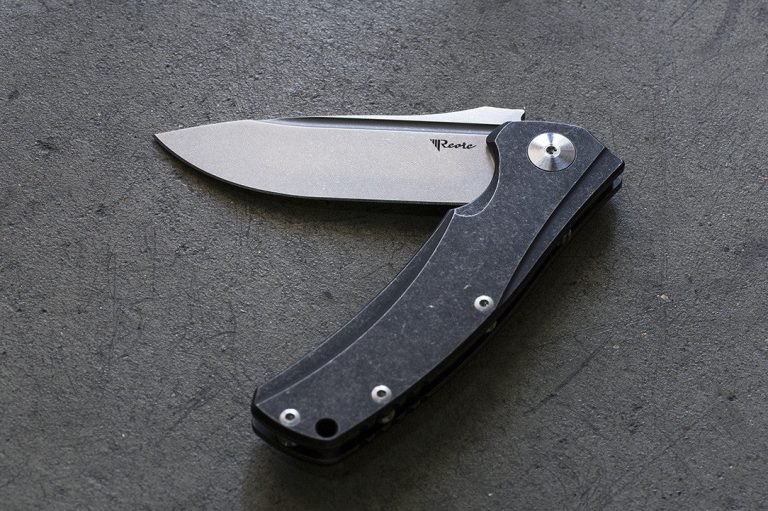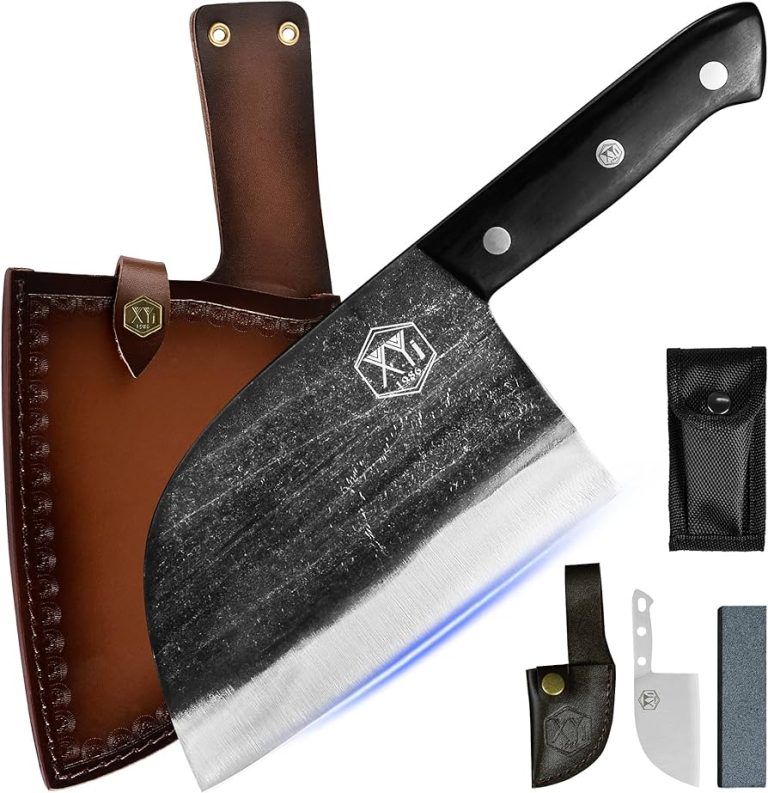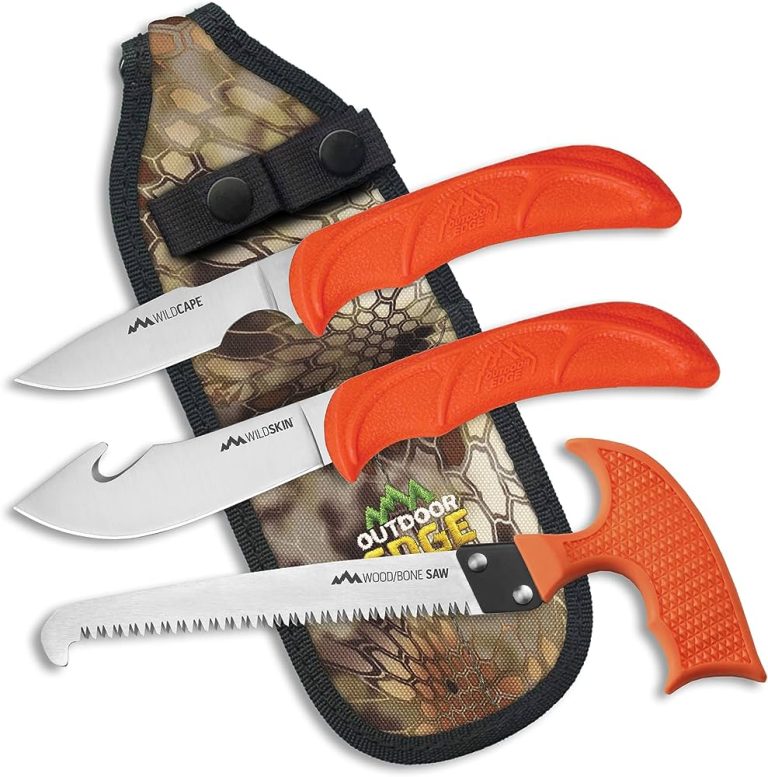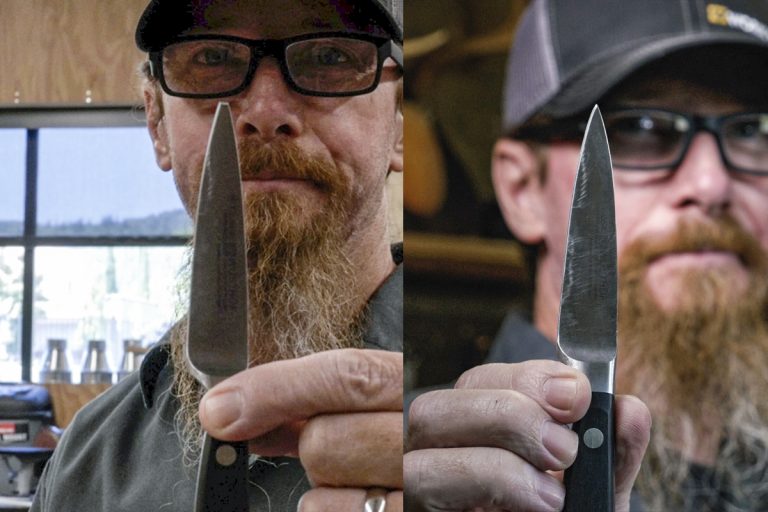Knife Skills 101: Techniques for Using Home Knives
Knife Skills 101: Techniques for Using Home Knives teaches essential cutting techniques for a variety of ingredients and provides tips for maintaining a safe and efficient kitchen. Whether you’re a beginner cook or an experienced chef, mastering these basics will enhance your culinary skills and make meal preparation easier and more enjoyable.
In this comprehensive guide, we will cover the proper grip, correct cutting motions, and the essential knives every home cook should have in their collection. By the end, you’ll feel confident using your knives and be ready to tackle any recipe with ease.
So let’s dive in and sharpen those skills!
The Importance Of Knife Skills
Mastering knife skills is essential for any home cook. This comprehensive guide will teach you the fundamental techniques needed to use your kitchen knives effectively in a variety of culinary tasks.
Mastering Knife Skills Enhances Your Cooking Experience
Mastering knife skills is an essential aspect of becoming a proficient home cook. It not only improves your cooking experience but also allows you to achieve professional-looking results. With excellent knife skills, you can save time and effort in the kitchen, making your culinary adventures more enjoyable.
Let’s delve into the importance of knife skills in greater detail:
Save Time And Effort In The Kitchen
- Efficiency: When you have mastered knife skills, you can chop, slice, and dice ingredients with precision and speed. This efficiency helps you save valuable time in the kitchen, allowing you to focus on other aspects of your meal preparation.
- Consistency: Proper knife techniques ensure that your ingredients are cut into uniform shapes and sizes. This consistency not only enhances the presentation of your dishes but also helps with even cooking. No more worrying about unevenly cooked vegetables or meat!
- Less wastage: When you know how to handle a knife properly, you reduce the chances of accidental injuries and, in turn, minimize food wastage. With improved control and technique, you can utilize every bit of your ingredients, maximizing their potential in your recipes.
Achieve Professional-Looking Results
- Aesthetics: Knife skills play a significant role in the visual appeal of your dishes. Whether you’re creating a beautiful garnish or delicately slicing ingredients for an elegant salad, mastering knife techniques enables you to achieve professional-looking presentation and elevate your culinary creations.
- Texture: Cutting techniques can affect the texture of your ingredients and, consequently, the overall mouthfeel of your dishes. With the right knife skills, you can slice ingredients to desired thicknesses or create specific textures, enhancing the eating experience for yourself and your guests.
- Confidence: When you have command over your kitchen knives, you gain confidence as a cook. This newfound confidence reflects in the way you handle ingredients and experiment with different recipes. It empowers you to explore new culinary horizons and continuously improve your cooking skills.
Mastering knife skills is an investment in your culinary journey. With practice and dedication, you can elevate your home cooking to new heights, saving time, achieving professional-looking results, and gaining confidence in the kitchen. So, grab your knives and embark on an exciting journey of honing your knife skills today!
Essential Knives For Every Home Cook
Master the art of home cooking with Knife Skills 101. Discover the essential knives every cook needs to create culinary magic in their kitchen. Perfect your techniques and elevate your dishes to new heights.
Chef’S Knife: The Workhorse Of The Kitchen
- A chef’s knife is an indispensable tool that every home cook should have in their kitchen. It is a versatile knife that can handle a wide range of tasks, making it the workhorse of the kitchen.
- This knife typically has a blade that is 6 to 10 inches long, with a slight curve for easy rocking motion while chopping or mincing.
- Here are some key features and uses of a chef’s knife:
- Blade material: High-quality stainless steel for durability and precision cutting.
- Weight: A heavy blade that provides stability and control.
- Uses:
- Chopping vegetables and herbs
- Slicing and dicing meat
- Mincing garlic and onions
- Crushing and smashing garlic cloves
- Cutting large fruits
- Mincing and dicing nuts
Paring Knife: Perfect For Precision Tasks
- A paring knife is a small, versatile knife that is perfect for precision tasks that require careful control and accuracy.
- This knife usually has a narrow, pointed blade that is about 3 to 4 inches long, making it ideal for tasks that require precision and delicate handling.
- Here are some key features and uses of a paring knife:
- Blade material: High-carbon stainless steel for sharpness and precision cutting.
- Weight: Lightweight for easy maneuverability and control.
- Uses:
- Peeling fruits and vegetables
- Trimming and shaping produce
- Removing seeds and cores
- Slicing small items like garlic cloves or shallots
- Creating garnishes
Bread Knife: Slicing Through Crusty Loaves
- A bread knife is specifically designed for slicing through bread and other baked goods with ease, thanks to its serrated blade.
- This knife typically has a long and narrow blade, ranging from 7 to 10 inches in length, and a serrated edge that bites into crusty surfaces without crushing the interior.
- Here are some key features and uses of a bread knife:
- Blade material: High-carbon stainless steel with serrations for clean cutting.
- Weight: Lightweight for smooth gliding through bread.
- Uses:
- Slicing crusty artisan loaves
- Cutting through soft and delicate pastries
- Dividing cake layers
- Creating even slices of tomatoes or citrus fruits
Utility Knife: Versatile And Multi-Purpose
- A utility knife is a versatile and multi-purpose knife that serves multiple functions in the kitchen, bridging the gap between a chef’s knife and a paring knife.
- This knife typically has a blade that is around 4 to 7 inches long, providing flexibility and maneuverability for various tasks.
- Here are some key features and uses of a utility knife:
- Blade material: High-carbon stainless steel for durability and versatility.
- Weight: Balanced for control and precision.
- Uses:
- Slicing sandwiches and sandwiches
- Trimming fat from meat
- Cutting larger fruits and vegetables
- Carving small roasts or poultry
- Chopping small herbs or garlic
Santoku Knife: Japanese Style All-Purpose Knife
- The Santoku knife is a Japanese-style all-purpose knife that has gained popularity in Western kitchens for its versatility and functionality.
- This knife typically has a shorter and wider blade compared to a chef’s knife, ranging from 5 to 7 inches, and features a flat edge with Granton indentations to prevent food from sticking.
- Here are some key features and uses of a Santoku knife:
- Blade material: High-carbon stainless steel for sharpness and edge retention.
- Weight: Lightweight for ease of handling and control.
- Uses:
- Slicing, dicing, and chopping vegetables
- Cutting thin slices of fish or meat
- Mincing garlic and herbs
- Scooping and transferring chopped ingredients
- Creating decorative cuts or patterns on food
Having a basic set of essential knives in your kitchen can significantly enhance your culinary skills. The chef’s knife, paring knife, bread knife, utility knife, and Santoku knife are all valuable tools that serve unique purposes and make various kitchen tasks more manageable.
Whether you are slicing, dicing, peeling, or carving, the right knife can make a world of difference in your cooking experience.
Knife Grips And Techniques
Learn essential knife grips and techniques for using home knives effectively. Enhance your knife skills with expert guidance and improve your kitchen efficiency.
Basic Knife Grip: Maintaining Control And Precision
- Hold the knife handle firmly, with your fingers wrapped around it.
- Place your thumb on one side of the blade, resting against the knife handle.
- Keep your other fingers curled underneath the handle for support.
- Maintain a relaxed grip, ensuring that you have control over the knife’s movement.
- This grip allows for precise cuts and reduces the risk of accidents.
Claw Grip: Safe And Efficient Way To Hold Food
- Curl your fingers on the hand that holds the food, resembling a claw shape.
- Tuck your fingertips inwards, away from the blade’s path.
- Use your knuckles as a guide, allowing the blade to come into contact with them and not your fingertips.
- This grip provides stability and prevents accidental cuts while maintaining control over the food being sliced or diced.
Rocking Motion: Mastering The Chopping And Dicing Technique
- Start by placing the tip of the knife on the cutting board and perform a rocking motion.
- Use the hand holding the knife to move it up and down in a rhythmic motion.
- As the tip of the knife comes down, apply pressure to cut through the food.
- Continue rocking the knife back and forth, using the entire blade to chop or dice efficiently.
- This technique allows for quick and precise cuts, saving time in the kitchen.
Slice, Dice, And Mince: Step-By-Step Instructions
- Slicing:
- Begin with a horizontal slice, placing the food flat on the cutting board.
- Hold the knife parallel to the cutting board and push it forward, applying pressure to slice through the food.
- Repeat the process, adjusting the thickness of the slices based on your preference.
- Dicing:
- Start by creating uniform slices.
- Stack the slices together and make equally spaced vertical cuts, creating cubes.
- Turn the cubes 90 degrees and make horizontal cuts to achieve diced pieces.
- Mincing:
- Using a claw grip, hold the food steady while keeping your fingertips away from the blade.
- Make repetitive chopping motions with the knife to finely chop the food.
- Continue until the desired mince consistency is achieved.
Chiffonade And Julienne: Achieving Thin And Uniform Cuts
- Chiffonade:
- Stack the leaves of herbs or leafy greens together.
- Roll the stack tightly, creating a cigar shape.
- Use a knife to make thin slices, producing fine, ribbon-like cuts.
- Julienne:
- Begin by cutting off the uneven sides of the food item.
- Create rectangular-shaped pieces of the desired thickness.
- Stack the pieces and make equally spaced vertical cuts to create thin, uniform strips.
Knife Care And Maintenance
Care and maintenance of your home knives is essential for optimal performance and longevity. Discover knife skills and techniques to ensure your knives remain sharp and efficient for all your culinary needs.
Proper Storage: Choosing The Right Knife Block Or Magnetic Strip
- Storing your knives properly is essential for their longevity and safety. Consider these options for storing your home knives:
- Knife block: Invest in a quality knife block that securely holds your knives in place. Look for one with slots that fit the sizes and types of knives you own.
- Magnetic strip: A magnetic strip mounted on your kitchen wall is a space-saving option. It allows you to display your knives while keeping them easily accessible. Ensure the magnetic strip is strong enough to securely hold your knives.
Cleaning: Handwashing Vs. Dishwasher
- Cleaning your knives correctly helps maintain their sharpness and prevents damage. Here are the preferred methods for keeping your home knives clean:
- Handwashing: It is recommended to handwash your knives to avoid exposure to harsh detergents that can dull the blades. Use a mild dish soap, warm water, and a non-abrasive sponge to gently clean your knives. After washing, dry them thoroughly with a cloth or towel to prevent rusting.
- Dishwasher: While some knives are dishwasher safe, it is generally not recommended. The high heat, powerful jets, and metal-on-metal contact can harm the blades and handles, leading to dullness or even breakage. To preserve your knife’s lifespan, stick with handwashing.
Honing Vs. Sharpening: Understanding The Difference
- Maintaining the sharpness of your home knives involves both honing and sharpening. Learn when to use each technique:
- Honing: Honing straightens the edge of the blade, keeping it sharp between sharpenings. Use a honing steel or rod to gently realign the blade’s edge by sliding it against the steel at a 20-degree angle. Honing is recommended after every few uses to maintain optimal cutting performance.
- Sharpening: Sharpening is necessary when a knife’s edge becomes dull. This process involves removing material from the blade to create a new edge. Use a sharpening stone or an electric knife sharpener following the manufacturer’s instructions. It is generally sufficient to sharpen your knives every 3-6 months or as needed.
Storing Knives Safely: Protective Covers And Blade Guards
- Safely storing your knives not only ensures their longevity but also minimizes the risk of accidents. Consider these protective measures:
- Protective covers: If you prefer to store your knives in a drawer, use individual protective covers for each knife. These covers provide a barrier between the blades, preventing them from scratching or dulling each other.
- Blade guards: Blade guards are another option for keeping your knives protected, especially for transport or storage outside of a knife block or magnetic strip. These guards cover the blade entirely, shielding it from accidental contact.
When To Seek Professional Sharpening Services
- While regular honing and sharpening at home can keep your knives in good shape, there are situations when professional sharpening services may be necessary:
- Damaged or heavily dulled blades: If your knives have chips, nicks, or are extremely dull, professional sharpening will ensure they are restored to their original sharpness.
- Lack of confidence or experience: If you are unsure about honing or sharpening techniques, it’s wise to have a professional handle the task. They have the expertise and specialized equipment to get the job done safely and effectively.
- Time constraints or convenience: If you’re short on time or prefer to have the convenience of having your knives professionally sharpened, seeking sharpening services is a convenient option.
Remember, proper care and maintenance of your home knives are essential for their performance and longevity. By storing them correctly, cleaning them with care, regularly honing, and sharpening when needed, you’ll ensure that your knives stay sharp and ready for any culinary task.
Knife Safety Tips
Master proper knife safety techniques with Knife Skills 101. Learn valuable skills in using home knives to ensure safe and efficient food preparation.
Using knives in the kitchen can be both rewarding and dangerous. To ensure safety while working with home knives, it is crucial to follow proper knife safety techniques. Here are some essential knife safety tips to keep in mind:
Choosing The Right Cutting Surface: Avoiding Damage To Knives
- Opt for cutting boards made of wood or polymer, as they are more forgiving to your knives compared to hard materials like glass or ceramic.
- Avoid using plates, countertops, or other surfaces that can dull or damage your knives.
- Replace cutting boards that have deep grooves or excessive wear to prevent the growth of bacteria and ensure clean and safe food preparation.
- Use a separate cutting board for meat, poultry, fish, and vegetables to avoid cross-contamination.
Proper Hand Placement: Minimizing The Risk Of Injury
- Hold the knife with a firm grip, ensuring your fingers are positioned away from the blade’s edge.
- Curl your fingers inward and rest your knuckles against the flat side of the blade while guiding the knife through the food.
- To prevent accidental slips, keep your non-dominant hand in a “claw” shape, with your fingertips tucked under and away from the blade.
- Never attempt to catch a falling knife. Instead, step back and let it fall to the ground safely.
Keeping Knives Sharp: Reducing The Chance Of Accidents
- Use a sharpening stone or honing steel regularly to keep your knives sharp. Dull knives can be more dangerous as they require additional force and can slip easily.
- Avoid using glass or granite cutting boards, as they can quickly dull your knives.
- Consider professional knife sharpening services if you’re unsure about sharpening them yourself.
Using A Cutting Board With Stability: Preventing Slips And Falls
- Place a damp kitchen towel or silicone mat underneath your cutting board to provide stability and prevent it from shifting during use.
- Ensure your cutting surface is clean, dry, and free from any debris.
- Maintain a well-lit kitchen to improve visibility and reduce the risk of accidents.
Handling Knives With Respect: Educating Children About Knife Safety
- Teach children how to handle knives safely, emphasizing the importance of never running or playing with knives.
- Store knives securely in a knife block or drawer with childproof locks to prevent unauthorized access.
- Supervise children closely when they are involved in food preparation activities that require the use of knives.
Remember, practicing proper knife safety techniques is essential to avoiding accidents and injuries in the kitchen. By following these tips, you can create a safe environment for preparing delicious meals while honing your knife skills.

Credit: www.youtube.com
Advanced Knife Skills To Level Up Your Cooking
Level up your cooking with advanced knife skills that will elevate your culinary game. Learn essential techniques for using home knives in this comprehensive guide to knife skills.
If you’ve mastered the basics of knife skills and want to take your culinary creations to the next level, it’s time to explore some advanced techniques. These advanced knife skills not only enhance the presentation of your dishes but also maximize flavors and ensure even cooking.
From creating beautiful vegetable shapes to deboning poultry with precision, these techniques will elevate your cooking game.
Tourne: Creating Beautiful And Decorative Vegetable Shapes
- Tourne is a French culinary technique that involves transforming vegetables into elegant, barrel-shaped cuts. This technique not only enhances the visual appeal of your dishes but also ensures even cooking due to the uniform shape of the vegetables.
- To create a tourne cut, follow these steps:
- Start with a large, round vegetable like a potato or carrot.
- Remove the ends and trim the sides to create a barrel shape.
- Use a paring knife and make seven symmetrical angular cuts around the vegetable, creating flat sides.
- Carefully round off the corners and create a smooth, tapered shape.
- Rinse the cut vegetable to remove any excess starch and continue using it in your recipe.
Filleting Fish: Removing Bones And Skin
- Filleting a fish is a skill worth mastering if you enjoy working with seafood. It allows you to remove bones and skin, leaving behind the succulent, boneless fillet ready for cooking.
- Here’s a simple guide to filleting a fish:
- Place the fish on a cutting board and make an incision behind the gills, angling the knife towards the head.
- Follow the natural curve of the fish, running the knife along the backbone, gently separating the flesh from the ribs.
- Carefully lift the fillet, keeping the knife close to the skin to avoid wasting any meat.
- Once you’ve removed one fillet, repeat the process on the other side of the fish.
- Use a pair of tweezers to remove any remaining bones from the fillets.
- Rinse the fillets under cold water, pat dry, and they’re ready to be cooked!
Deboning Poultry: Removing Bones With Precision
- Deboning poultry allows you to cook and present a whole bird without the hassle of carving around bones. This technique requires patience and precision but is well worth the effort.
- Follow these steps to debone poultry:
- Start by removing the wings and legs of the bird.
- Make an incision along the backbone on one side and use the knife to separate the flesh from the rib cage.
- Slowly work your way around the entire bird, using the knife to delicately separate the meat from the bones.
- Be careful around the joints and wishbone, ensuring not to tear the flesh.
- Once you’ve completely deboned the bird, you can stuff it, roll it, or cook it whole, resulting in a beautiful presentation and uniform cooking.
Butterflying Meat: Maximizing Flavor And Even Cooking
- Butterflying or spatchcocking meat involves splitting it open along the backbone, resulting in a flat and evenly cooked piece. This technique is ideal for grilling, roasting, or stuffing meats like chicken, turkey, or pork.
- Here’s how to butterfly meat:
- Place the meat on a cutting board, breast-side down for poultry.
- Use a sharp knife or poultry shears to cut along one side of the backbone, from tail to neck.
- Repeat the process on the other side to completely remove the backbone.
- Open up the meat like a book and lay it flat on the cutting board.
- Apply gentle pressure to flatten the meat, ensuring it’s even and ready to be marinated, stuffed, or cooked.
- Butterflying meat not only reduces cooking time but also helps flavors penetrate evenly, resulting in a delicious and succulent dish.
Frenching: Presenting Elegant And Refined Dishes
- Frenching refers to the technique of trimming the bones of meat to expose them and create an elegant and refined presentation. This technique is commonly used with cuts like racks of lamb or bone-in roasts.
- To French meat, follow these steps:
- Use a sharp knife to scrape away any excess meat and fat from the bones, exposing them.
- Trim the sinew and excess fat to create a clean and uniform appearance.
- Make sure to scrape the bones clean, removing any bits of meat or cartilage.
- Frenching not only enhances the visual appeal of your dish but also allows for easy handling and serving.
- Remember, presentation is key when it comes to creating elegant and refined culinary masterpieces.
Now that you’ve learned about these advanced knife skills, it’s time to put them into practice. Whether you’re impressing guests with beautifully tourne vegetables or presenting a perfectly filleted fish, these techniques will take your cooking to new heights. So grab your knives, sharpen them if needed, and let your culinary creativity soar!
Frequently Asked Questions On Knife Skills 101: Techniques For Using Home Knives
What Are The 5 Basic Knife Skills?
The 5 basic knife skills are: chopping, dicing, slicing, mincing, and julienning. Master these for efficient food preparation.
How Do You Use Knives At Home?
To use knives at home, hold the handle firmly, keep fingers away from the blade, and use swift, controlled motions.
How Do You Master Basic Knife Skills In Knife Cuts 101?
To master basic knife skills in knife cuts 101:1. Begin by holding the knife properly, with a firm grip and your fingers tucked away. 2. Practice different cutting techniques, such as the slice, dice, and chop, using a variety of ingredients.
3. Pay attention to your hand placement and start with slow, deliberate movements. 4. Gradually increase your speed and accuracy by practicing regularly and seeking guidance from experienced chefs.
What Are The 4 Knife Techniques?
The 4 knife techniques include chopping, slicing, dicing, and mincing.
Conclusion
After going through this comprehensive guide on knife skills, you should now feel confident in your ability to use home knives efficiently and safely. Remember to always choose the right knife for the task at hand, maintain a firm grip, and use the proper cutting techniques to achieve the best results.
Regularly sharpening and honing your knives will keep them in excellent condition, ensuring clean and precise cuts every time. Incorporating these techniques into your cooking routine will not only enhance your efficiency in the kitchen but also elevate your culinary skills.
So, put your newfound knowledge into practice and impress your family and friends with your improved knife skills. Happy cooking!






